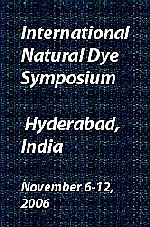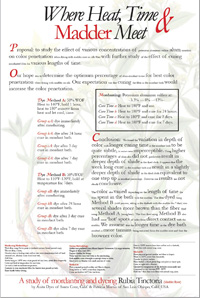International Natural Dye Symposium
by Patricia Martin
Color Me Wild
"Put-Put-Put"—That is the sound the auto rickshaw made as we tried to direct the driver to the Shilpakala Vedika Conference Center through hand signals, a combination of our English and his Hindi, or through one of 325 recognized languages and dialects in India. My friend and I had been traveling through India for the past couple of weeks, so we were somewhat comfortable getting around. We had done all the "tourist" things first on our trip, including a visit to the Taj Mahal and a sunrise ceremony on the river Ganges. Now we were looking forward to the final part of our itinerary, the International Natural Dye Symposium in Hydrabad, India. I had attended the Color Congress in Iowa and knew I could not miss this one. The first International Colour congress held in 2002 had over 200 participants from 23 countries, and we were told that this event would be much larger, and due to it's location, would attract a more international audience.
Although we almost missed the opening ceremonies due to rush hour traffic and communication issues with our driver, we did make it. The International Natural Dye Symposium was held in Hyderabad—the most modern city we had visited in India. That city and the organizers of the symposium welcomed us most graciously. As we approached the building, the energy surrounding it was so invigorating it made us forget our troublesome travels. Seven hundred participants from 57 countries had made similar journeys, but all of us were there for one reason alone, and it was time to get down to business.
The Craft Council of India, UNESCO, and Dr. Dominique Cardon deserve the highest praise for making this event an overwhelming success. Both the Color Congress and the International Natural Dye Symposium brought together educators, artists, scientists and business people, all with a passion for the use of natural dyes. We gathered to gain information and hopefully, affirmation that our work with natural dyes is making valuable contributions to our own societies. For some, it is about keeping a cultural heritage alive as a sustaining and viable livelihood. For me, it is about the richness of colors to be attained from elements of the earth, in an artistic manner, and without damaging its processes. The symposium, which was held on November 5-12, 2006, was set up with two sessions each day for the week, with extracurricular activities on most evenings. The panels were varied, with the speakers describing specific projects, and imparting specific messages.
The subjects of the panels included:
| 1. | Natural dyes today: Declines and Revivals; | ||
| 2. | Natural dyes today: A global heritage; | ||
| 3. | A global heritage with a social impact: Gender and rural development issues; | ||
| 4. | Sustainability and eco-friendliness of natural dyes; | ||
| 5. | Scientific and technical advances; | ||
| 6. | From the past to the future of natural dyes: The contribution of archaeological and anthropological research; | ||
| 7. | Economic development and marketing of natural dyes: case studies; and | ||
| 8. | Synergies for the development of natural dyes: The role of government, NGO's (Non-governmental organizations associated with the United Nations), producers, consumers. |
Each session was presided over by a moderator who, in most cases, kept everything on time, and offered insights by summarizing each session. There was a coffee and tea break between each session, and, as those who have attended such gatherings can attest, this can be the most useful and exciting part of a conference. The International Natural Dye Symposium, with it's wealth of knowledgeable persons from literally every corner of the world, proved to be a treasure trove of idea-sharing and impassioned advocacy for every aspect of natural dyeing. Every person I met was fascinating, in terms of their motivations for attending the symposium, their thoughts on the challenges facing natural dyers, and what they personally were doing to make a change or to educate others about natural dyes. It was an especially pleasant surprise to meet many young fashion designers whose future contributions will hopefully bring about greater knowledge of natural dyes. Seeing their designs and use of natural dyes was inspirational.
Many different evening activities were planned for the delegation, so that they could witness the true culture of India. For instance, on the first evening, there was a presentation of Rang-Kuchipudi, a traditional dance. There was also a modern dance called "Indigo Memory" by Nasser Soumi, which was performed on three evenings at dusk. A fashion show at Chowmohalla Palace featured established, as well as up-and-coming young designers, using natural dyes and exotic fibers with a strong Eastern influence. One perfect evening included a "Chowki" dinner with traditional regional fare served at low tables with the guests sitting on the ground supported by bolsters. On another evening, we visited the Golconda Fort for a light and sound show with local history and romance, and if you were not careful, a mosquito attack. On the last evening we were all taken to a beautiful farm and welcomed with a flower-laden ox and sitar and tambal drum music. Dinner was “faire” style (standing). Alamwaar, the local design house who sponsored the evening, presented their fabrics.
Between the sessions and evening activities were many opportunities to explore the vendors who came to share their local regions’ textiles and commercial enterprises. A second craft fare (bazaar) was also held on the grounds. These vendors were chosen by their states in India, and honored as masters of their traditional craft. This was their opportunity to showcase and sell their work.
The demonstration area was popular for gathering new information and techniques in the use of dyes. Each day four to seven people would share some aspect of their craft. Many subjects were covered, such as how to prepare an indigo bath, how to mordant, and how to use dye materials on the surface of fabrics. There was such a wealth of information available that it was difficult to choose what to attend. Not the least important were two showings and the poster exhibition. The first showing was an exhibition of Kalimkari design—a traditional technique using natural dyes and a thickened iron paste to hand-draw on fabric. Originally, these works, which often depict specific scenes, were for the use in Hindu temples. The second showing featured a large body of work by some of the symposium speakers that showcased what they do as artists or represented work from their region. The work was masterful! Finally, there were at least twenty poster presentations. Although several were simply advertisements for a natural dye company or material, in other cases they presented findings ranging from simple studies on mordant usage, to masters' theses on using plant materials, and the influence of time of year and mordants on colors. Most conveyed useful and interesting information.
 Turkey Red Journal
Turkey Red Journal

